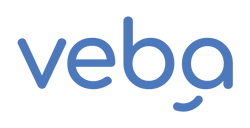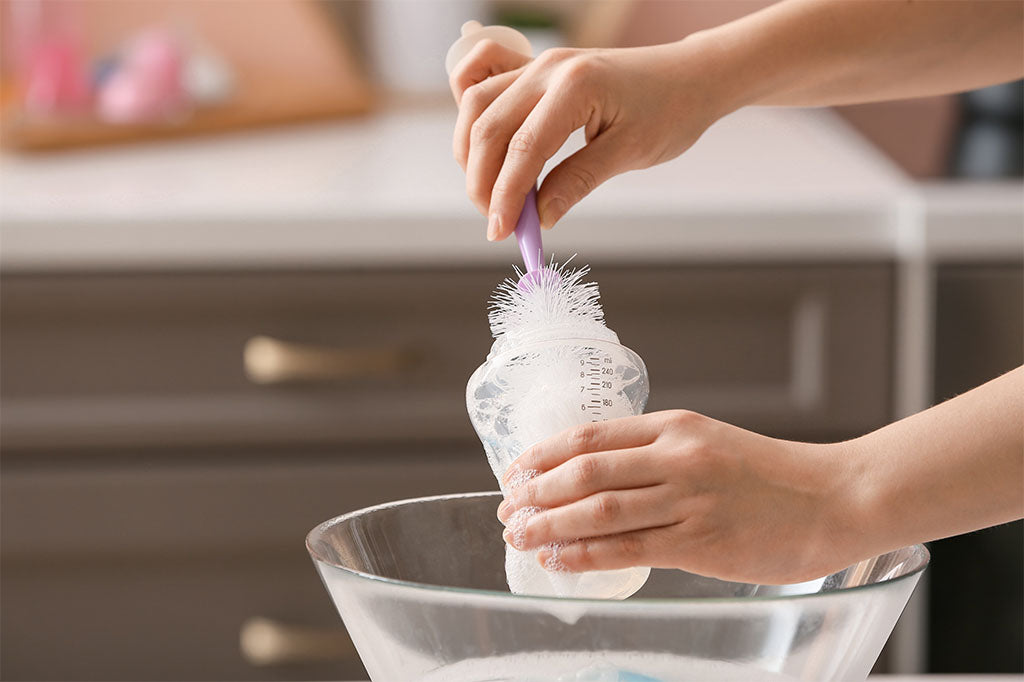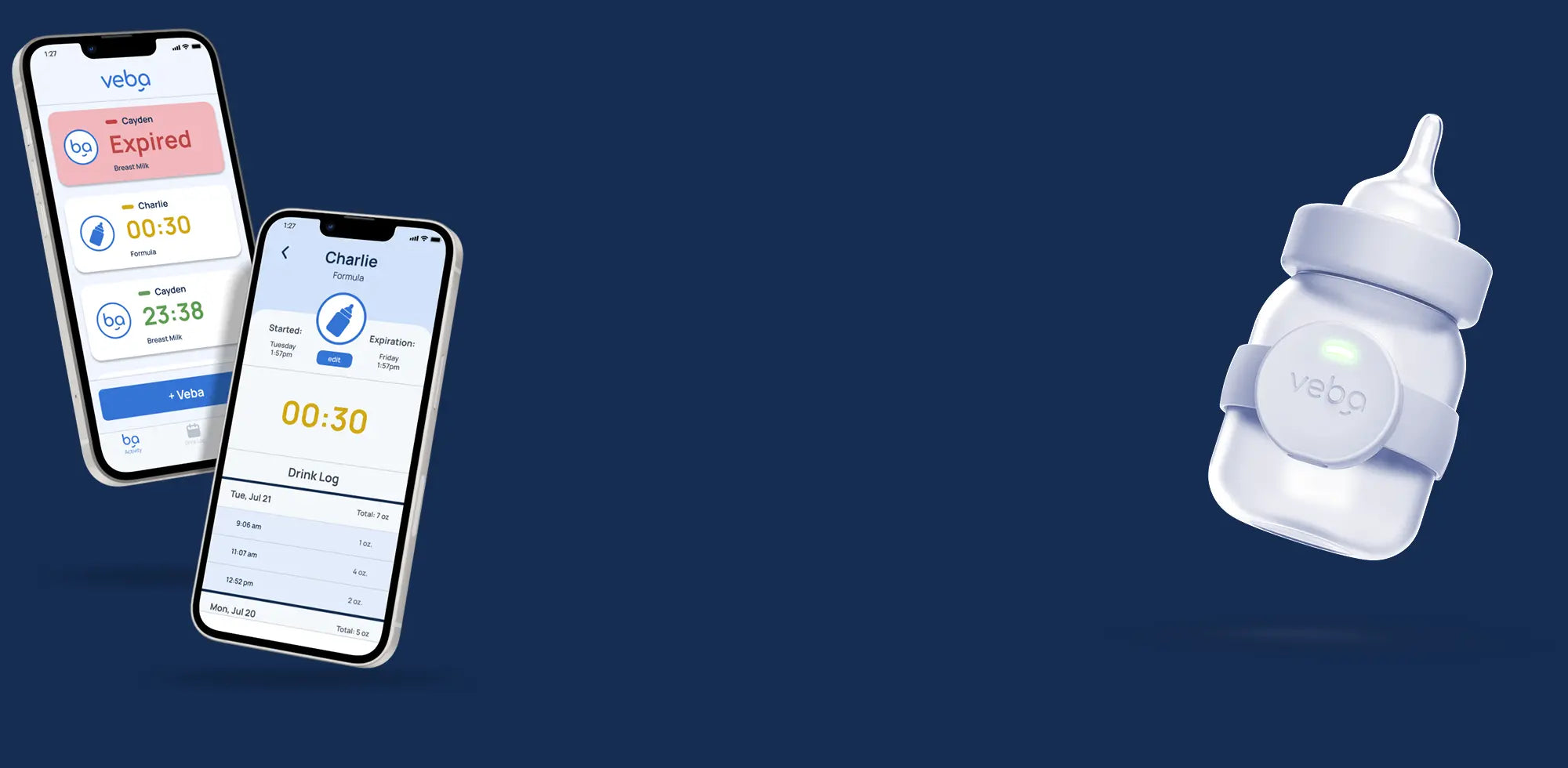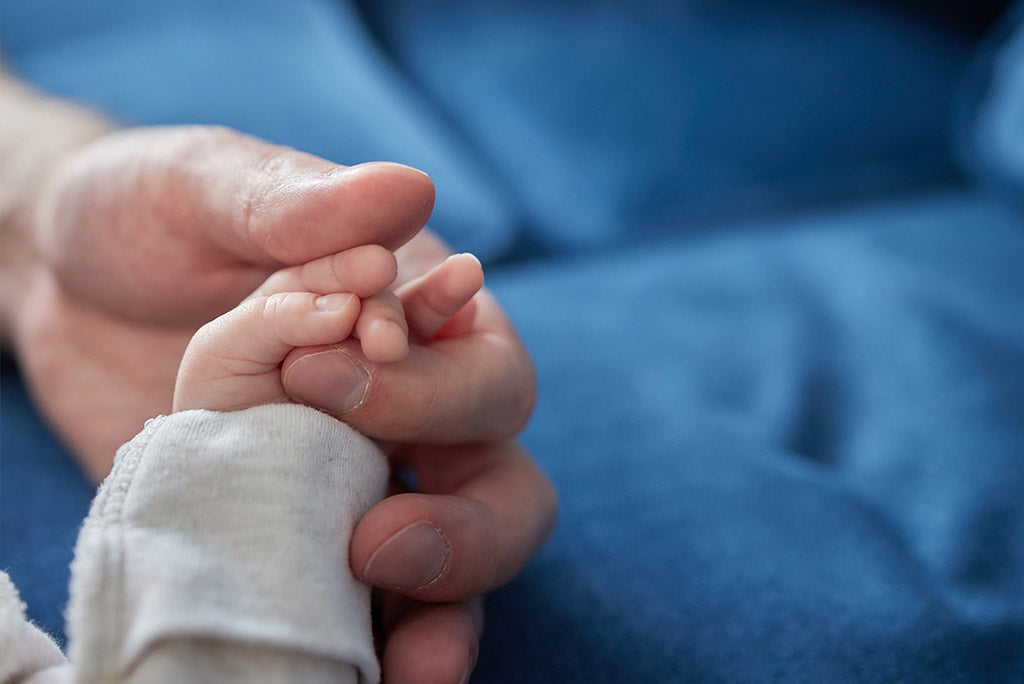Any new parent with a bottle in hand knows… After the feeding is over and before relaxing with a nap or the excitement of playtime can begin, there is a dreaded task: cleaning baby bottles. Bottle-feeding parents know the sizable chore, and cause for stress, of properly cleaning and sanitizing their baby’s feeding items. The risk of not getting them perfectly clean and your baby getting sick is more of a flat out fear than a mild concern. Especially for babies who are under the age of 2 months, have a weakened immune system, or are born prematurely.
At Veba Baby, our purpose is to make bottle-feeding a non-stressful experience and to bring you peace of mind. So to make this task feel less anxiety provoking and more empowering, we have detailed this guide on proper baby bottle cleaning and sanitizing tips according to the latest, most trusted data from the CDC. So, if you’re ready to clean like a dream, make sure you have your feeding items in hand and let’s get scrubbing!

Prep
ScheduleFirst things first! Before we start scrubbing to our hearts content, it’s important to know your cleaning schedule. Which should be after every feeding, no questions. If your baby has not consumed the remaining liquid in their bottle after 2 hours, you simply need to dump it. Don't mix more formula in and don't just rinse the bottle. The bottles need to be completely emptied, cleaned fully (we’ll tell you how!), and give your little one fresh milk or formula in a fresh bottle at the next feeding.
GatherBefore you start cleaning baby bottles right and left, you’re going to need to gather all of your feeding items and your cleaning supplies. That means brushes and washing basins too! It is crucial not to forget anything and let it sit to grow bacteria or thrown in with the rest of the dishes and washed haphazardly. Don’t forget your drying rack if you’re using one! Just like your other feeding items, it needs to be regularly cleaned and sanitized too.
AvoidGot everything? Great! Before you start washing, check to be sure you’re not using feeding machines or whisks and spoons to prepare formula. These can be tough to clean properly and put your baby at a higher risk of getting sick. The safest method for preparing formula is inside the feeding bottle. Just give it a shake!
PreventThat means you also probably shouldn’t have your formula scoop poised for cleaning either. Keeping the formula scoop dry is crucial to protecting the formula and reducing the likelihood for it to become contaminated. So, avoid cleaning the formula scoop unless it is clearly dirty from a drop on the floor or in the sink, or carried away by a furry friend. Take care of it in the same way you would when cleaning baby bottles. No worries, we will explain! Then be sure it has air-dried 100% before it goes back in the formula container.

Self-Cleaning
If you’re planning to wash your bottles by hand, we’re pretty sure you can guess the first step. Wash those hands! Don’t forget to use soap and water and scrub those digits for at least 20 seconds. Once you’re nice and clean, it’s time to get those bottles squeaky too. Start by making sure the parts are all disassembled and separated from each other. That means bottles, nipples, caps, etc….and rinse all of the separated feeding parts under running water. Remember, you should always avoid placing them in the sink as the sink can be a germ’s paradise, contaminating your items. Instead, grab your clean washing basin (a dedicated container for washing your feeding items) and fill it up with hot water soapy water. Use your dedicated brush (only for cleaning feeding items) and get scrubbing! When you’re cleaning baby bottles it’s important to be thorough so you don’t miss a single spot. That means making sure the soapy water makes its way through the holes in the nipples too! Then, rinse the items (including the wash basin and bottle brush) thoroughly under running water. Now, you’re ready to let them dry! If you’re using dishwasher safe brushes and basins, go ahead and pop them in there every few days on a hot water or heated dry cycle setting. If your baby has a weakened immune system or is under the age of 2 months, or was born premature, wash them after every use and sanitize them regularly by boiling, steaming, or soaking them in bleach according to manufacturer directions. More on this later!
Machine-Cleaning
If you’ve decided to skip the old fashioned way and go straight to modern machines to help you with cleaning baby bottles, we feel you! Here’s what you have to do to do it right. Take everything apart just like you would to hand wash. Be sure all of the parts like caps and nipples are separated. Then, give the items a rinse first under running water. Next place them securely in the dishwasher where they are unlikely to fall. Tiny items should go inside a closeable basket or mesh bag to keep them put. Then, turn the dishwasher on using the hot water and a heated drying setting, or better yet, the sanitize setting if you’ve got it!
Once you hear that sweet ding sound that the cycle is over, wash your hands extra good with soap and water before you touch any of the items. Prepare a place to air dry any items that might be a little damp still. Assess each piece to make sure it is totally and completely dry before storing it. If it's not, pop it on your air dry spot. More on this later!
Sanitizing
ScheduleIf you’re reading this you’ve probably got a very little one on your hands! That means, if they are under 2 months old, were born prematurely, or have a weakened immune system you have to sanitize all of their feeding items at least once daily, or ideally after each use. Once your baby gets older or if they are healthy and strong, you can likely get away with sanitizing less often so long as the items are thoroughly cleaned. If you opt to use a dishwasher or special infant feeding item cleaning and sanitizing machine, with hot water and a heated drying cycle or sanitize option, you can skip these steps as the machine has done the work for you!
OptionsLuckily, there are a few options for how to sanitize baby bottles! Boil, steam, or bleach. Whichever option you choose, be sure that you have cleaned the items already, including brushes, basins, and even the drying rack if you’re using one! Next, peek at the directions from the manufacturer for each item to find out which methods you can use safely with your product. Finally, disassemble and separate all of the parts before you get started. To boil, drop the parts in a pot filled with water, bring it to a boil and let it bubble furiously for 5 full minutes. Then, use clean cooking tongs to remove the items. If you opt to steam instead, put the parts in the microwave or use an electric steamer. Be sure to use the advice provided by the manufacturer for sanitizing and drying the feeding items safely.
BleachFinally, bleach. This option might sound a little scary, but it’s a great option if you can’t use any of the others. Here’s how to do it. The CDC recommends creating a solution in a clean wash basin with 2 teaspoons of unscented bleach per gallon of water. Submerge all of the items fully so that the solution can really get into every nook and cranny. That means getting the solution through the nipple holes too! Be sure to also check to make sure that there are no air bubbles inside the bottles. Give the items a minimum of 2 minutes to soak before you remove them with clean tongs. Be sure to avoid rinsing as this could be counterproductive to the sanitizing process. If you’re worried about the dangers of the bleach for your baby, don’t be! Any of the solution left on the bottles will rapidly break down as it dries. That means once it is dry it’s baby safe!

Drying and Storing
Whether you did a thorough clean or a full sanitize, you’re going to need to make sure that your items are properly dried and stored to keep them clean before you use them again. But here’s a hot take straight from the experts… Air drying your feeding items on a fresh paper towel or clean dish towel is the best way to go. Don't try to dry them yourself as you risk trapping the dirt and dust right in there. Some machines will dry them for you and if you ask us, this is great, so long as they've got a HEPA filter.
But experts recommend that you skip the drying rack and opt for a fresh paper towel or dish towel instead. Why? They can be tough to clean and are capable of trapping the excess moisture in instead of letting things fully dry out how they’re supposed to. That can spell growth of mold and germs — yuck. If you opt to use the drying rack anyway, be sure to reserve it just for use when cleaning baby bottles and other feeding items. Not unlike you do with your other feeding items, be sure to clean it well and often. That means every couple of days or even every day if your baby is younger than 2 months old, has a weakened immune system, or was born premature. Wash, sanitize it, and air dry 100% to avoid germing (or molding) up your freshly cleaned feeding items.
Storing
Ready to be done with the cleaning and back to staring lovingly at your little one? We know the feeling! But, before you even think about touching those squeaky clean bottles, be sure to wash your hands extra thoroughly with soap and water. Make sure everything has had a chance to air-dry fully before you stash it for the next use. This is crucial to avoid germs from getting on them and also allowing mold to grow. Totally dry? Great, put everything back together as you wish and put it all away, including bottles, brushes, and washing basins in a protected area that is nice and clean. We recommend a closed cabinet with a door out of reach of curious pets or equally curious older kids.
At Veba Baby, we aspire to provide only the best information and the most cutting-edge technology to help parents and caregivers take care of their babies in the best ways possible. We hope you found these baby bottle cleaning and sanitizing tips helpful. But we totally understand if you still have some worries about keeping your baby safe throughout the entire feeding process. That’s why we have innovative the only smart baby bottle monitor that tracks breastmilk and formula freshness in real time! You can learn more or shop now on our website! Or, to get more expert information and tips on bottle-feeding, stay tuned to our blog The Sip, where peace of mind is just a click away!




